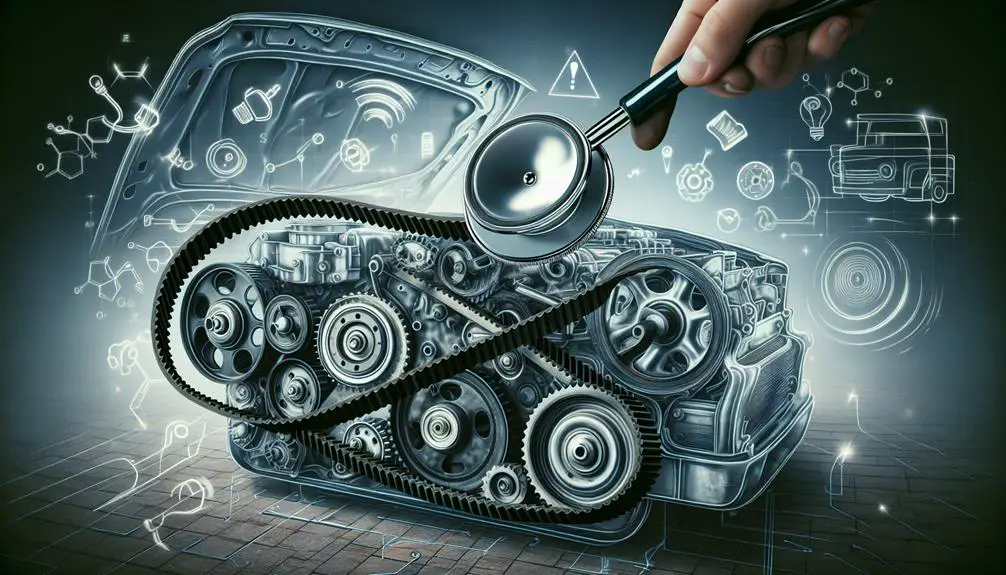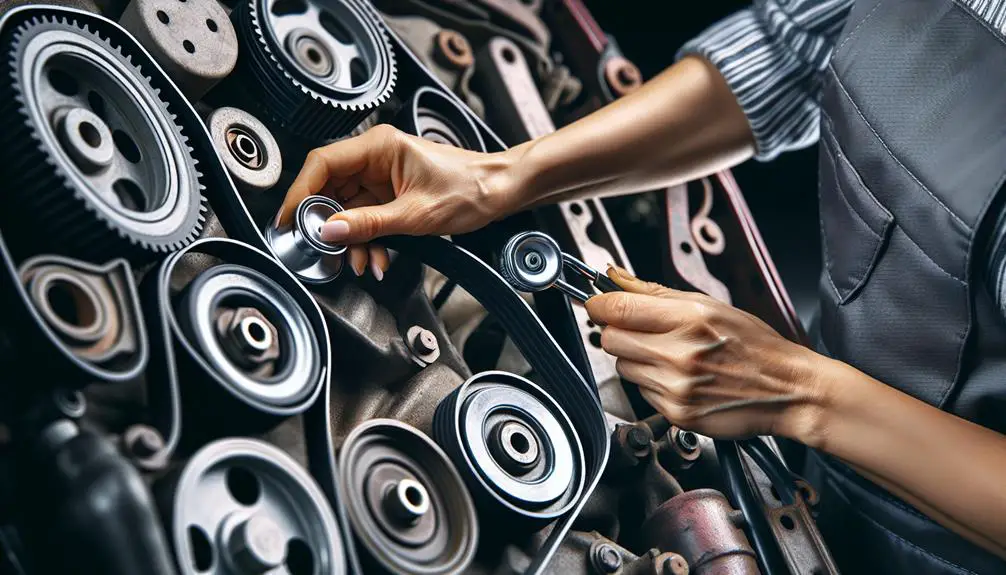Diagnosing serpentine belt noise involves several steps:
- Listening for squealing or chirping sounds
- Inspecting the belt, pulleys, and tensioner
- Determining the cause of the noise to prevent potential damage.
These steps are crucial in identifying and resolving any issues with the serpentine belt system.
Identifying Belt Noise

To accurately identify serpentine belt noise, it's vital to listen for a distinctive squealing or chirping sound emanating from the engine bay. This specific auditory cue is a primary indicator of belt wear or misalignment and not to be confused with other engine noises. You'll often hear it more prominently during startup or when the vehicle's power demands increase, such as with the air conditioning on or while steering.
Comprehending the timing of the noise can be critical in diagnosing the issue. If the sound appears intermittently and is more pronounced during wet conditions or high humidity, it could point towards a need for belt lubrication or tension adjustments rather than replacement. However, constant noise, regardless of weather conditions or engine load, suggests more severe wear or misalignment.
Applying a diagnostic approach involves not just identifying the noise but also correlating it with specific engine operations or environmental conditions. This detail-oriented process helps in ruling out other potential sources of sound within the engine bay and focuses on the serpentine belt's condition and performance. Remember, belt lubrication or tension adjustment may temporarily mitigate the noise but won't solve underlying issues if the belt is significantly worn or misaligned.
Inspecting the Serpentine Belt
After pinpointing serpentine belt noise as the culprit behind the unsettling sounds from your engine bay, it's imperative to conduct a thorough inspection of the belt itself. Begin with a visual inspection to assess the belt's condition. You're looking for signs that could indicate wear or damage, which might be causing the noise.
During your inspection, pay close attention to:
- Cracks or fraying along the belt's surface. These are clear indicators that the belt is deteriorating and may soon fail.
- Glazing on the belt's ribs. A shiny, smooth surface suggests the belt has been slipping, which not only produces noise but also reduces the belt's efficiency.
- Contamination by oil or coolant. Such substances can degrade the rubber, leading to premature wear and noise.
If you spot any of these issues, it's a strong indication that the belt's condition is compromised and likely contributing to the noise you've heard.
Checking Pulleys and Tensioner

Once you've examined the serpentine belt for wear and damage, it's important to check the pulleys and tensioner for any signs of malfunction that could be contributing to the noise. Start with pulley alignment; misaligned pulleys can cause the belt to run unevenly, leading to excessive wear and noise. You can check alignment by looking at the belt's position on the pulleys. It should sit squarely, not skewed to one side. If you notice misalignment, it's a sign that the pulleys may have been installed incorrectly or have shifted over time.
Next, focus on the tensioner. Proper tensioner operation is crucial for maintaining the correct amount of pressure on the serpentine belt. Too much or too little tension can lead to belt slippage or increased wear, both of which can generate noise. Check the tensioner arm for smooth operation; it shouldn't be stuck or overly difficult to move. Furthermore, inspect the tensioner for signs of wear or damage.
Tensioner lubrication is also key. A lack of lubrication can cause the tensioner pulley to seize or operate roughly, contributing to noise. Make sure the tensioner is adequately lubricated to guarantee smooth, quiet operation.
Understanding Noise Causes
Identifying the specific cause of serpentine belt noise requires a detailed examination of different engine components, including the belt itself, pulleys, and tensioner. It's important to understand that both engine types and noise frequency play significant roles in pinpointing the problem. For instance, diesel engines might exhibit different noise characteristics compared to petrol engines, because of their distinct operating mechanisms.
When considering noise frequency, it's vital to distinguish between a continuous squeal and intermittent chirps. These variations can indicate different issues:
- A constant squeal often suggests a worn-out belt or misaligned pulleys.
- Intermittent chirps may point towards debris entangled in the belt or pulley system.
- High-pitched whining, especially at engine start, could indicate a tensioner that's failing to maintain proper belt tension.
Repair or Replace the Belt

Having pinpointed the cause of serpentine belt noise, deciding whether to repair or replace the belt is your next step. Belt maintenance is important for a smooth-running engine and avoiding further complications. When considering noise solutions, keep in mind that not all issues warrant a replacement. Some can be resolved with minor adjustments or repairs. However, comprehending the condition of your serpentine belt and the nature of the noise is key to making the right decision.
| Condition | Repair Possibility | Replace Necessity |
|---|---|---|
| Minor wear | Possible lubrication or tension adjustment | Not necessary |
| Cracks | Not recommended | Immediate |
| Glazing | Surface treatment might help | Advised |
| Material loss | No repair possible | Required |
| Misalignment | Adjust pulleys | If damaged |
If the belt shows signs of severe wear, such as deep cracks, significant material loss, or if it has become glazed, replacing it is the safest bet to prevent breakdowns. For less severe conditions, like minor wear or misalignment, corrective measures may extend the belt's life. Always prioritize safety and performance in your decision-making process.
Conclusion
After closely identifying the belt noise and thoroughly inspecting your serpentine belt, including a detailed check on pulleys and the tensioner, you've pinpointed the root causes of the noise.
Whether it's wear, misalignment, or tension issues, comprehending these factors is essential.
Now, based on your diagnosis, you'll decide if a repair suffices or a complete replacement is necessary.
Remember, precision in diagnosis guarantees the longevity of your belt system, maintaining your vehicle's performance efficiently.